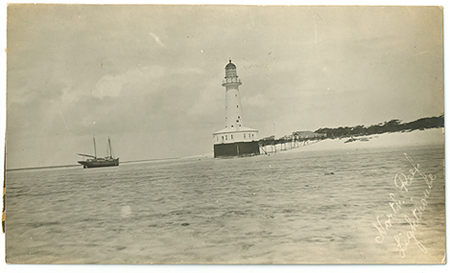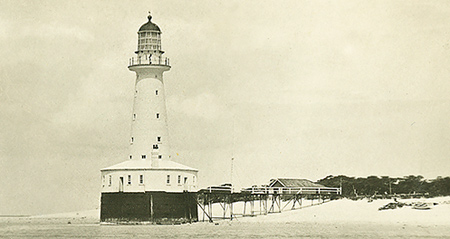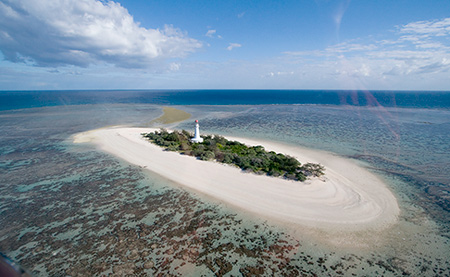Marking time in October 2011
A postcard from North Reef
My favourite Queensland lighthouse is the one at North Reef, about 120 km north east of Gladstone. The lighthouse was built in 1878 on a small patch of sand on a coral reef, supported on a concrete-filled iron caisson founded on the coral. It is the tallest example of its type, and the most remarkable. Because the lighthouse is remote from the mainland, and is difficult to approach by boat, few visitors went there and old photographs are very rare.
I went to the North Reef lighthouse in 2006 for my nationwide survey project. I flew in and out with an Australian Maritime Systems maintenance crew by helicopter—an exciting and efficient way to get a great view of the tower and the reef.
I have just acquired this photograph of the site, with a story attached—a tale of danger, isolation, and hunger:


Generally, lighthouse keepers were expected to be married men, and a cottage was provided for each keeper, his wife, and their children. But at North Reef it was judged too costly and difficult to build cottages on the shifting sand, so the lighthouse was designed as a ‘bachelor station’ with rooms for the keepers built around the base of the tower.
There were three bed rooms, two sitting rooms, two kitchens, and one store room. I suppose it was expected that the Head Light Keeper would have his own kitchen and sitting room, while two Assistant Light Keepers would share the other kitchen and sitting room. Each kitchen was originally equipped with an open brick fireplace, with nothing so convenient and labour-saving as a wood stove.

It must have been a lonely life for the keepers. Perhaps once or twice each year a government steamer from the Queensland Department of Harbours and Rivers (or, after 1912, from the Commonwealth Lighthouse Service) would have visited, to replenish the stock of kerosene, paint, and other supplies, and to carry out major maintenance. Periodic deliveries of food, kitchen firewood and other supplies were brought by private contractors according to a schedule that was sometimes upset by bad weather or breakdowns. The keepers paid for their own food, but the government paid the contractor for the delivery service.
NORTH REEF LIGHTHOUSE.
Men Almost Starving.
Only 60 Miles From Gladstone.
Mr. W. Hodge, motorboat man, Gladstone, who has secured the contract for the provisioning and supply of firewood for Cape Capricorn, Bustard Head, North Reef Lighthouse and Lady Elliott Island, took on the first of his trips on Monday week last in his auxiliary schooner Lyola. Leaving here on Monday evening the crew comprised Mr. W. Hodge (skipper), Messrs. H. M’Callum, W. J. Bensted, C. Thomas and a relieving hand for the station at North End from whence a start was made at 1.45 a.m. on Tuesday for the North Reef Lighthouse. With a strong south-easterly breeze, a rough passage was experienced right across to North West Island, which lies some 15 miles north* of the lighthouse, where a camp was made in shelter for the night, the anchor being dropped at 7 p.m. Leaving again at 6.30 on Wednesday morning, a run was made for the lighthouse and the schooner taken across the reef and beached under the lighthouse, and on an examination of her bottom after the tide went out it was found that several sheets of copper had been ripped off with the heavy seas experienced. The Lyola is the first vessel that has crossed over the reef and anchored under the lighthouse. The inmates of the lighthouse (three men) were not long in rushing down looking for provisions, and no wonder, when it became known that the men had been practically starving for a week, their only food having been turtle eggs and a little cornflour. It was found that it was nine weeks since the last Government steamer had been to the island with provisions and wood, and had it not been for the care taken in rationing what little they did have the occupants of this lonely islet would have been in a very sorry plight. Only three calls of the Government steamer had been made within the last seven months and yet it is expected of these men to have their light clean and burning every night to light the passing ships on their way and warn them of one of the horrible reefs that exist on our coast. Is this fair? This lighthouse, with a revolving two-minute light and 80ft. high, was built in 1872 on a small island of about an acre in extent, but with all the heavy winds and seas the sandy part of the island has been shifted a short distance from the lighthouse and the only access to this part is by a small bridgeway. The lighthouse itself, which is built on a 500-ton concrete foundation, is surrounded by water after half tide and the inmates are practically prisoners till the tide recedes again, The Lyola left the lighthouse again on Wednesday night for North West Island and sheltered till morning, when a run was made for North End, which was reached in good time, and after a short stay waiting for the tide a start was made for home, which was reached an hour later. The Lyola throughout proved herself a splendid little craft under capable hands and Mr. Hodge is to be complimented on securing this contract and there is no doubt that in future the wants of these lonely people will be looked after in a better manner than they have been in the past. Some fine views of the lighthouse and also the Lyola lying at anchor under the lighthouse have been secured by Messrs. Bensted and Thomas and are on view in their respective windows. Mr. Hodge will run to each of these stations once a month from now on and will be pleased if any person who has any spare reading matter, to send along same to him which will be willingly delivered. The first trip to Lady Elliott Island will be made this week.

*27 August 2022—A helpful reader has sent me an email, pointing out that North West Island lies to the south-west of North Reef. I checked on the Admiralty chart, and what he says is correct.